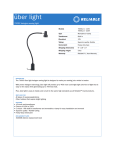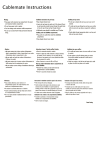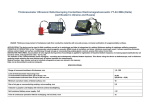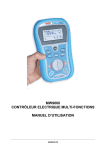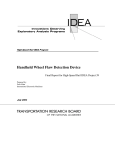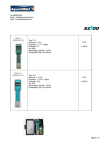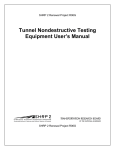Download Electromagnetic-Acoustic Transducers for in
Transcript
17th World Conference on Nondestructive Testing, 25-28 Oct 2008, Shanghai, China ELECTROMAGNETIC-ACOUSTIC TRANSDUCERS FOR IN-SERVICE MANUAL TESTING OF HEATED OBJECTS Vladimir T. BOBROV, Andrey A. SAMOKRUTOV, Viktor G. SHEVALDYKIN JSC “Spectrum-RII”, Moscow, Russia Tel/Fax: 007 (495) 984-74-62; e-mail: [email protected] Abstract The problems of Ultrasonic Testing (UT) of metal products and constructions with the surface being heated up to 300-800C are considered. It is noted that the process of UT of objects at chemical plants of heat-power, metallurgy industry etc complicates the need to protect Ultrasonic transducers from heated surfaces, hot air and heat radiation from objects, with the operational conditions becoming dangerous. We offer to use electromagnetic-acoustic (EMA) excitation and signal reception technique that does not require direct mechanical contact of the transducer with a heated surface of the object under test. The EMA transducers (EMAT) are protected from thermal influence by a thin shield made of heat-resisting material with low thermal conductivity; they do not require the use of couplants and are intended to be used as a part of a serial EMA gauge A1270 for testing of products heated up to 3000C with no additional heat-shielding. The designed time mode follows the scheme. This enables the transducer to work reliably for 8 hours. Such a successful design of the EMAT and the use of a composite protector made of alumina ceramics provide reliable test parameters. The same EMAT can be used to test objects heated up to 7000C. There is a developed carrying-in and -out system for the EMAT. The system is provided with a heat-resisting shield that protects the EMAT from thermal influence of the object under test and significantly reduces the influence of it onto an operator. The designed time modes for testing of objects at different temperatures prevents the operating part of the EMAT from overheating and, at the same time provides multiple measurement of heated object thickness. Also there is compensation of the thermal influence from an object onto the US wave velocity. Key words: EMAT, heated products, heat-resistant material, US velocity 1. Introduction Ultrasonic testing is the most appropriate and easy way of wall thickness measurements in standard conditions, but is complicated to apply when coming to the objects with high surface temperatures (300-800 0С), which are common in chemical industries, at power plants, metallurgy plants and similar. The usual problems appearing in this case are: absence or very expensive couplants necessary for ultrasonic testing, the necessity of special protection for transducer from high-temperature impact from object surface, from hot air and thermal radiation from the hot object, the working conditions are not comfortable or even dangerous for the operators. The electro-magnetic acoustic (EMA) way of ultrasound excitation and reception [1-5] approved itself as the most applicable method in these difficult conditions, as it does not require any couplants for a good acoustic contact between the transducer and the heated testing surface. The construction of EMA transducer is less complicated then of a conventional piezo-electric transducer, as it contains less parts and materials, exposed to damages due to high temperatures. But the main advantage of EMA transducer for this application is that it can work without the direct mechanical contact with the heated surface, therefore during the testing process it can be protected from thermal impact with the thin screen from heat-resistant material with low thermal conductivity. The standard construction of EMA transducer not specially prepared for testing of hightemperature objects is enough resistible to the heat. When using the special materials for contact plate and housing of the transducer, the resistance to temperatures can be significantly increased. Another way to improve the heat-resistant characteristics is to use additional screens and layers between the contact plate of the transducer and the testing object. The parts in the construction of the EMA transducer mostly imposed to the thermal impact are the induction coil and its protection from mechanical damages. The protector with built-in electro-magnetic screen has the thickness of only 0.3-0.4 mm and is made from the composite material with alumina ceramics base and epoxy binder. The maximal temperature it can be imposed to during quite a long time without influencing its characteristics is not higher then 1200C. At temperatures higher then 150 0C the protector is destroying. For a short period (several seconds) the protector can be heated to 1500C keeping its characteristics. As the protector has low thermal conductivity it can also protect the inductor located on the film printed circuit board. Therefore in a definite testing mode the EMA transducer can be applied for testing hot objects even without heat protection. 2. Results of experiments To assess the surface temperature limit for testing with serially produced EMA transducers without special heat protection and also for determining the possible and allowed testing regimes the trials and experiments were made researching heating and cooling dynamics of protector at periodical placing the EMA transducer on hot metallic surface. The research methods were in measuring the time interval when the protector’s temperature of the EMA transducer placed on the heated to a definite temperature metallic surface achieves the maximum permissible value for the protector material. Additionally the time interval for cooling down of the protector till a certain temperature was measured to estimate the pause necessary between the measurements. For the experiments the model of EMA transducer was prepared, fully repeating the construction of transducer without inductor, but with thermal sensor in the protector. Another thermal sensor was placed on the internal side of the housing close to the protector. Hereafter when describing the experiments made the model of EMA transducer we will be called the EMA transducer. The object of testing is the aluminum plate 8 mm thick with built-in thermal sensor. The plate was heated to the set temperature and this temperature was kept by the thermo regulator. Fig.1 shows the dependence of protector’s temperature in the area of inductor in EMA transducer without heat protection from the time of thermal contact of transducer with the surface of aluminum plate heated to 300 0C. Fig. 2 shows the dependences between the temperatures in the area of inductor and of the housing near the protector of EMA transducer without heat protection and the time passed from removing the transducer from the plate heated to 300 0C. The temperature of transducer’s inductor at the moment of removing from the plate was 1500C. 2 Temperature, deg. C Time, sec Fig. 1. Dependence of inductor’s temperature of EMA transducer without heat protection from the time of its contact with object’s surface heated to 300 оC. The graph on the fig. 1 shows that at 3000C temperature of testing object the operator has 5-7 second for one measurement. This time is enough for getting the thickness reading on the display of electronic unit and saving this reading to the memory of the device. On the 8th second the inductor’s temperature (as well as the temperature of the protector) achieves the critical value of 1500C. At that temperature the material of the protector is not yet damaged, but at a higher temperatures the characteristics of protector’s material will be destroyed. To cool down the EMA transducer after its contact with testing object the interval of several minutes is required (see fig. 2). In 1.5 minutes after removing the transducer from the hot surface it’s temperature comes close to 600C. From the graph on the fig. 1 is clear, that the inductor achieves this temperature already in 1 second after placing the transducer on the hot surface. That’s why if to start measurements when the inductor’s temperature is about 60 0C, then the acceptable interval of contact between the EMA transducer and the testing object will be equal to 4-6 seconds. Basing on that the recommended testing regime for object with temperature of 3000C is as follows: 5 seconds for measurement, 2 minutes – minimal pause for cooling the transducer, at that the additional time of half a minute is added. The experiments on the testing object with temperature of 5000C showed that the inductor heats to the temperature of about 1300C within 2.6 sec. Due to the quick heating and thermosensor persistence can be concluded that the temperature of external surface achieves the critical 3 Temperature, deg. C value already within 2.6 sec or even exceeds this value. As a result of several trials the protectors were partly damaged, though the inductor was not heated to critical 150 0C. Time, min Fig. 2. Dependence of inductor temperature (1) and protector’s frame temperature (2) from time of cooling down after contact with hot testing object 300 оC. The time of 2 seconds is not enough for one measurement, meaning it is not possible to use the serially produced EMA transducer without special heat protection on the objects with surface temperature of 5000C. For estimation of applicability of EMA transducer for wall thickness measurements on 5000C surfaces with heat protection from 0,2 mm thick fiberglass material the experiments on heating and cooling dynamics were done. The fiberglass has low thermal conductivity and doesn’t loose its characteristics at heating to temperature of 10000C and has silver-pale color, therefore it behaves as a heat-insulator and also as an effective screen from heat radiation from heated surface of testing object. The graph of inductor heating dynamic (fig. 3) shows that in this case the operator has about 8 seconds for one measurement; hereafter the transducer should be cooled down. The cooling time of the EMA transducer with fiberglass protection is lower in comparison to the one on the fig. 2 (1 curve). On the curve showing inductor’s temperature/time dependence, similar to the one on the fig.2, all temperature points (except for the initial point) are higher on 15-17 degrees then the Y-coordinate points of curve 1 on the fig. 2. For example, in 1 minute after taking the transducer off the 5000C hot aluminum plate the temperature of the inductor from 1500C falls to 81 0C, then in 2 minutes – to 740C, in 4 minutes – to 60 0C. This confirms that using the simplest heat protection from 1 layer of fiberglass 0.2 mm thick it is possible to test 4 Temperature, deg. C objects heated to 5000C. At that the testing mode will be as follows: 5 sec for measurements, 5 min – pause for cooling down (1 min added for secure). The use of fiberglass protection when testing objects with temperature of 300 0C can reduce the time between the measurements in comparison with application of non-protected EMA transducer. At 5 sec contact of transducer with the 3000C testing object the minimal pause between measurements can be 1 minute. Time, sec Fig. 3. Dependence of inductor’s temperature in EMA transducer with heat protection from fiberglass from time of contact with testing object surface heated up to 5000C. When using two layers of fiberglass 0.2 mm thick (the total thickness of protection then 0.4 mm) the objects with temperatures up to 7000C can be tested. At that the testing mode should be as follows: 4 sec – measurement, 5 min – minimal pause between measurements. The manual testing of hot objects is not safe for the operator. To protect the operator’s hands from strong infrared radiation from the hot surface of object testing should be made in special gloves. But at that when holding the hand close to the metallic object heated to 500-7000C the cloths can get burned, that’s why it is not possible to hold the transducer in hand even in glove. 3. Construction of EMA transducer for hot objects testing application To avoid injuries of the operators a simple handle was developed, allowing the operator to place the EMA transducer to the testing surface holding hand on a distance from the hot object. The handle (fig. 4) is about 500 mm long with connected EMA transducer on one side, the cable from the transducer is placed inside the handle. The fiberglass protection (one or two layers 5 depending on the temperature of testing object) is fixed on the EMA transducer with a clamp, therefore the fiberglass can easily be removed and replaced. Fig. 4. EMA transducer for testing the hot objects: left – without heat protection; right – on the handle with heat protection from fiberglass. Conclusions On the results of made reseaches and trials we can conclude the following: (1) The EMA transducer of general application without thermal protection can be used for measurements on objects heated up to 3000C. At temperature of 3000C the following testing mode is applied: 5 seconds – contact with hot surface, 2 minutes pause for cooling down. (2) As a heat protection for the EMA transducer the fiberglass up to 0.5 mm thick can be used. (3) Using the protection from fiberglass 0.2 mm thick testing of objects with temperatures up to 5000C is possible, at that the following testing modes should be applied: - for object with temperature 3000C: 5 seconds for contact with object, 1 min - pause; - for object with temperature 5000С: 5 seconds for contact with object, 5 min – pause. (4) The allowed testing modes are approved after multiple “contact-pause” measurement series at environmental air temperature of + 24 0C. In case of higher environmental temperature the longer pauses for cooling down between measurements are necessary after 5-7 series of measurements. 6 References [1] S.J.Gurevich, J.G.Galzev, A.D.Kaunov, System for noncontact ultrasonic testing of tubes at high temperatures. Defectoscopy, No 3, 1986, pp27-50 [2] Steven P. Clart, John H. Flora, Daniel T, MacLauchlan, High temperature electromagnetic acoustic transducer (EMAT) probe and coil assemblies. Pat. USA No5689070. November 18, 1997 [3] Jonathan D. Buttram, John H. Flora, High temperature electromagnetic acoustic transducer.Pat. USA No 6125706. October 3, 2000. [4] I.Baillie, P. Griffith, X. Jian and S. Dixon. Implementing an ultrasonic inspection system to find surface and internal defects in hot, moving steel using EMATs. Insight, v.49, No 2, 2007, pp. 87-92 [5] www.bwxt.com/operations/emat.html 7







